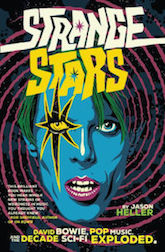Quick: when someone says “science fiction and pop music”, who do you think of?
These days, depending on your tastes and avidity for what’s new out there, it would not be entirely surprising if your mind jumped to Janelle Monáe. But a lot of people are going to immediately think of David Bowie—to whom Monáe herself would acknowledge a debt. Fittingly, he is the organizing principle of Jason Heller’s Strange Stars: David Bowie, Pop Music, and the Decade Sci-Fi Exploded. Heller—a Hugo-winning music writer who has contributed to Pitchfork, the AV Club, the Atlantic, and the New Yorker—starts with “Space Oddity” and ends with “Ashes to Ashes”, and in between he provides a whirlwind survey course of how science fiction shaped popular music and pop culture from 1970 to 1980. He weaves a chronological narrative of science fiction-influenced music—some world-changingly significant, some probably best forgotten—and science fiction’s rise in popular culture, occasioned by everything from Star Trek to the novels of J.G. Ballard and Samuel Delany, to—of course—Star Wars.
Buy the Book


Strange Stars: David Bowie, Pop Music, and the Decade Sci-Fi Exploded
It’s a delightful overview of a singular decade, though a study that is more broad than deep—several subjects can and have had lengthier book-length disquisitions devoted to them, such as Simon Reynolds’s Rip It Up and Start Again on post-punk and the library shelf’s worth of biographies and analyses of David Bowie. If you seek a deep critical discussion of any of the subjects Heller touches on, you may need to look elsewhere. But Heller’s encyclopedic knowledge of the period draws connections between works that you might not have been aware of, and contextualizes the musical, literary, and cinematic landscape of the 1970s.
For such a slim volume, there is a surprising amount of information packed into each chapter, and the pace can be relentless. The chapter on 1972 begins with David Bowie’s first performance as Ziggy Stardust at the Toby Jug pub in London, touches on Burroughs and Moorcock briefly before moving on to Elton John’s “Rocket Man”, then zips through Pearls Before Swine, T. Rex, Alex Harvey, Genesis, the Kinks, and Deep Purple. There’s a pause to take in “Star Trek Lives!” at the Statler Hilton in Manhattan (allegedly the first Star Trek convention) and Alvin Toffler’s Future Shock, and then we’re back to Bowie again, as he retires Ziggy Stardust after the July 3, 1973 performance at the Hammersmith Odeon.
Somewhat inevitably, nearly every musician cited in the text is discussed in terms of how they knew Bowie, were reacting to him, or were influenced by him, even at a second- or third-degree remove. Other recurring players include Michael Moorcock (alongside, Hawkwind, who were both influenced by him and bandmates with him, variously as Hawkwind or as members of The Deep Fix), Stanley Kubrick, whose 2001: A Space Odyssey and A Clockwork Orange were both influences on Bowie himself, and William S. Burroughs, whose works inspired musicians ranging from Bowie to Duran Duran.
The most attention is given to what you’d consider musical household names: Pink Floyd, Rush, King Crimson, as well as the original Afrofuturist Sun Ra, and George Clinton and Parliament-Funkadelic. Heller also includes some serious music nerd deep cuts as well, such as guitarist Bill Nelson’s band Bebop Deluxe, and some odd one-off novelties, like Hot Gossip’s “I Lost My Heart to a Starship Trooper” (featuring Sarah Brightman on lead vocals). As you’ll gather from the list of bands mentioned here already, the focus is primarily on American and UK bands and musicians, with the exception of German acts like Kraftwerk, Can, and Cluster. As well, few women figure in this narrative, with the notable exception of Poly Styrene of X-Ray Spex. No question, she earns her place in these pages, but apart from her, it’s disappointing to find women largely in supporting roles in these pages; if there were other female musicians operating in a science fiction mode in this era, it’s hard to tell.
The best thing about Strange Stars is that you will come away from it wanting to know more about almost everything Heller writes about—and this is not meant to damn with faint praise. Heller has organized a seemingly impossible narrative out of elements as disparate as Krautrock, Michael Moorcock’s Eternal Champion novels, the BBC Radiophonic Workshop and Doctor Who, Devo, the “Funky Robot” dance, and even—yes—the notorious Star Wars Christmas Special, and somehow has managed to do it such that it doesn’t feel like he’s stretching to make his points. In fact, it’s enlightening to see laid out all in one place just how pervasive science fiction themes and motifs were in the 1970s. Why this is, and what it reflects about American and British culture at the time, are larger discussions beyond the scope of this book.
Consider Strange Stars an excellent jumping-off point for further explorations—and read it with headphones on and Spotify open on your computer or phone.
Strange Stars is available now from Melville House.
Karin Kross lives and writes in Austin, TX, and performed “I Lost My Heart to a Starship Trooper” for competitive karaoke once. She can be found elsewhere online at hangingfire.net, on Tumblr, and on Twitter.










